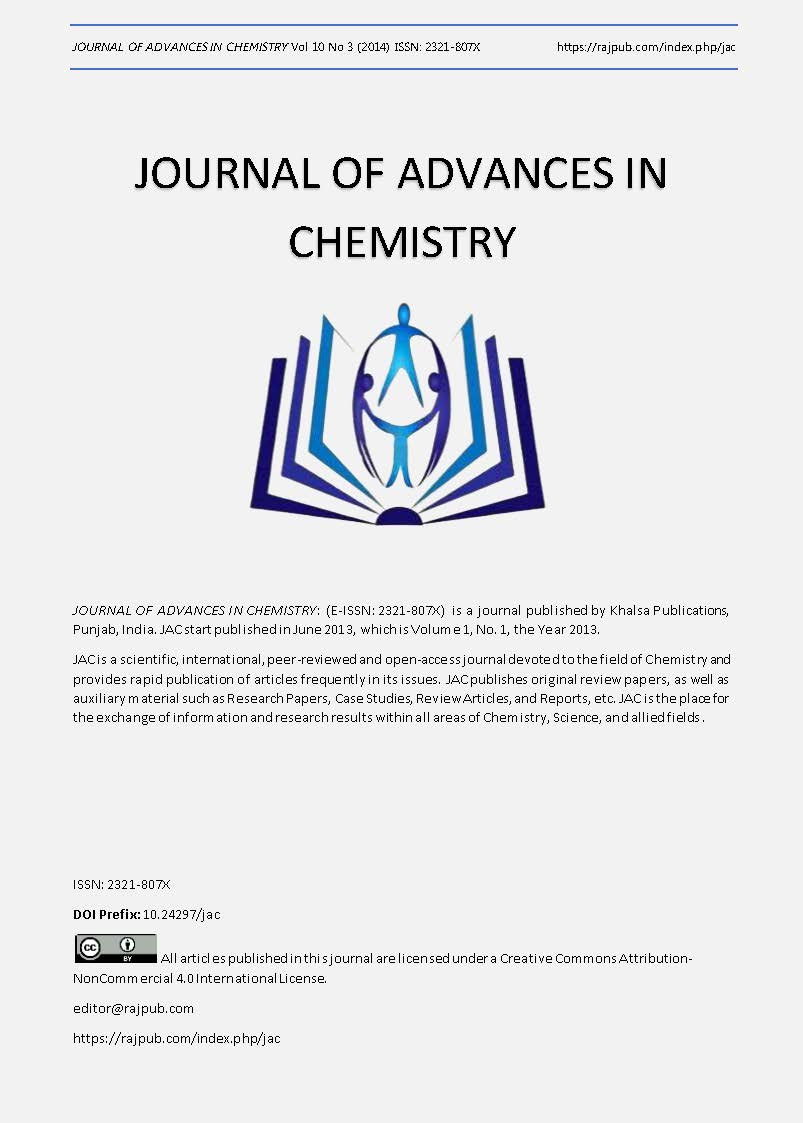Dehydration and decomposition behavior of the NaH2(PO4)0,48AsO4)0,52.H2O compound in the temperature range from 253 K to 333 K.
DOI:
https://doi.org/10.24297/jac.v10i3.6655Keywords:
Phase transition, Raman Spectroscopy, XRD powder, Ion conductivity, Dehydration-DecompositionAbstract
The mixed compound NaH2(PO4)0.48(AsO4)0.52.H2O, which has been examined by Raman spectroscopy, XRD powder and dielectric, exhibits solid–solid phase transitions and one reversible solid–liquid phase transition. Besides, the investigation of dehydration behavior of sodium dihydrogenate phosphate-arsenate monohydrate was undertaken in a temperature range from 253 K to 333 K. The onset temperature of dehydration was determined from changes in ionic conductivity and X-ray powder on heating. It was confirmed by the Raman study not only in the disappearance of the vibrations assigned to the PO4, AsO4 but also in the appearance of the new vibrations attributed to the (PO3), which constitutes the P-O-P chain, giving a polymer with the formula: NaH2(P2O7)x(As2O7)(1-x). The important variation was observed in all studies at 313 K, which could correspond to the transformation of the NDAP compounds of a solid crystal into a liquid form.
Downloads
References
[2] N. Ennaceur, Kh. Jarraya., I. Ledoux-Rak, A. Singh, T. Mhiri, Journal of Physics and Chemistry of Solids 73 (2012)418.
[3] Kh. Jarraya, N. Ennaceur, M. Elmarssi, T. Mhiri, Physica B Condensed Matter, 406 (2011) 1546.
[4] E. Ortiz, R.A. Vargas, B.E. Mellander, Solid State Ionics, 125 (1999) 177.
[5] K.S. Lee, J. Phys. Chem. Solids, 57 (1996) 333.
[6] E. Ortiz, R.A. Vargas, B.E. Mellander, J. Phys. Chem. Solids, 59 (1998) 305.
[7] E. Ortiz, R.A. Vargas, B.E. Mellander, J. Chem. Phys., 110 (1999) 4847.
[8] B. Marchon, A. Novak, J. Chem. Phys., 78 (1985) 2105.
[9] N. Ohno, D.J. Lockwood, J. Chem. Phys., 83 (1985) 4374.
[10] B.K. Choi, J.J. Kim, Jpn. J. Appl. Phys., 24 (1985) 912.
[11] J. Baran, J. Mol. Struct., 162 (1987), 211.T = 333 K : dehydration-decomposition (Polymerization) Reversible Phase Transition T = 313 K
[12] H. Naïli, T. Mhiri, A. Daoud, Phase Transit. 71(1999) 271.
[13] H. Naïli, T. Mhiri, A. Daoud, International Journal of Inorganic Materials, 4 (2001) 393.
[14] E. J. Baran, M. B. Vassallo, K. H. Lii, Vibrational Spectroscopy, 10 (1996) 331.
[15] M. Abdelhedi, L. Ktari, M. Dammak., A. Cousson, A.W. Kolsi, J. of Alloys and Compounds, 460(1-2) (2008) 147.
[16] H. Naïli, L. Vendier, J. Jaud, T. Mhiri, Solid State Sciences, 3 (2001) 677.
[17] M. Dammak, A. Hadrich, T. Mhiri, J. of Alloys and Compounds, 8 (2007) 428.
[18] Y.K. Taninouchi, T. Uda, Y. Awakura, A.Ikeda, S.M. Haile, J. Mater. Chem., 17 (2007) 3182.
Downloads
Published
How to Cite
Issue
Section
License
 All articles published in Journal of Advances in Linguistics are licensed under a Creative Commons Attribution 4.0 International License.
All articles published in Journal of Advances in Linguistics are licensed under a Creative Commons Attribution 4.0 International License.




